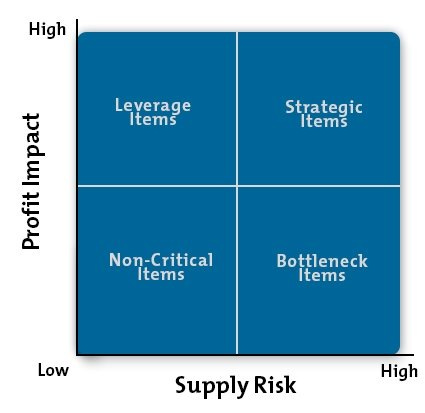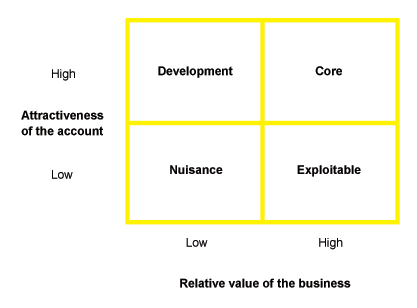An important part of defining the current state of IT in order to inform your IT Strategy involves developing and making explicit your current supplier landscape, in doing this there are 4 key questions to answer and 4 key techniques with which to answer them
- What is your view of your current IT Suppliers?
- How do your current IT Suppliers view you?
- What are the gaps or failings in capability that are required to be filled in order to deliver your strategy?
- Of the capability gaps to be filled or failings to be addressed, which are right to be filled by suppliers?
Having an incongruent mix of suppliers that do not fit your IT, your organisation and your strategy will cause your strategy to fail.
1) What is your view of the current IT Suppliers?

The Kraljic matrix provides a useful way of dividing up your current suppliers into 4 categories:
- Non-critical: Suppliers/product in high supply in the marketplace and of limited risk or impact to your business
- Leverage items: suppliers/products in high supply in the marketplace but whose importance to the business is high
- Bottleneck items: Low business impact but high supply risk
- Strategic items: Key suppliers/products that have both a high impact on the business and a volatile or high supply risk
Analysing your portfolio of suppliers using this technique will help make explicit your views on your suppliers and inform how you need to manage them.
2) How do your current suppliers view you?
Another matrix is useful here (sorry!)

The Supplier Preference model requires you to again categorise your suppliers but this time in terms of how they view you based on “attractiveness of the account” and “relative value of the business”. This requires some honesty and removal of ego (maybe you aren’t as important as you think you are). A good clue to help guide you in this analysis is simply to just reflect on the state of your current relationships with the suppliers. How your account manager treats you and how their senior people treat you (if at all) is probably the simplest shorthand for where they sit on this matrix.
Once you’ve completed your analysis you now have your suppliers categorised by Two matrices, this short exercise should give inform how you plan to address your supplier landscape in your IT Strategy.
3) What are the gaps or failings in Capability that are required to be filled in order to deliver your strategy?
In previous posts we’ve mentioned the value of understanding and mapping business capabilities. A Business Capability model can be used as a backdrop to overlay your key suppliers, which can then be combined with other overlays (e.g. mapping key suppliers to key capabilities, failing capabilities). We’ll touch on business capability modelling in a future post but for now the key message is, in order to understand the value and impact that a supplier has on your business you have to be able to map it back to a capability model.
4) Of the Capability gaps to be filled or failings to be addressed, which are right to be filled by suppliers?
Mapping your suppliers to your business capabilities will help identify your key suppliers and potential issues with your key suppliers. An important next step is to analyse whether the capabilities that your suppliers deliver are the right capabilities to be outsourced and whether there are others that could be. An extremely useful tool in this context, that we have mentioned before, is Wardley maps. Use Wardley maps to bring together a) your understanding of your supplier landscape b) your understanding of the business capabilities that your suppliers help deliver with c) and understanding of where those capabilities sit in terms of evolution, at this point you can then make informed decisions about your strategic suppliers and whether you have the right suppliers delivering the right capabilities or whether you have the right capabilities being delivered in-house.
Summary
So in this newsletter we’ve covered a lot of ground around techniques that you can use to help you think about your IT suppliers and thereby inform how you plan to address suppliers in your IT Strategy. This is crucial. If your strategy fails to address failings in your supplier landscape then you will be unlikely to successfully execute your IT Strategy.
Please don’t forget that in addition to subscribing to this newsletter you can also list to the accompanying podcast here and on all major podcast platforms.
If you’d like to learn more about how to create great IT Strategies then please consider signing up for early access to the course at howtoitstrategy.com
